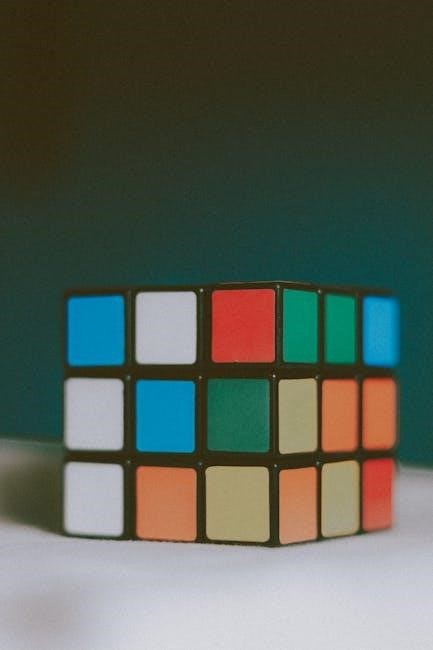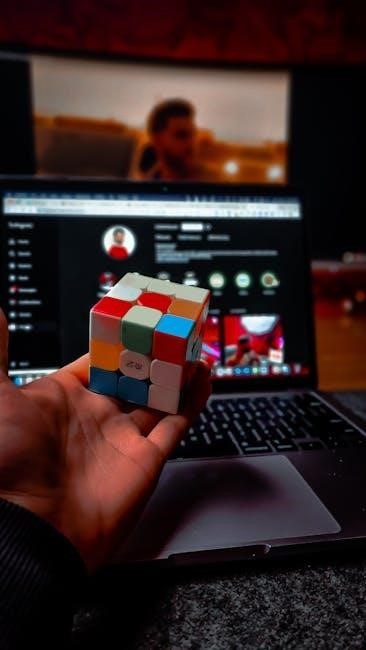To solve a 2×2 Rubik’s Cube‚ start by learning basic notation and
- simple algorithms
that will help you understand the cube’s structure and solve it efficiently‚ as seen in various online tutorials.
Understanding the Notation
To solve a 2×2 Rubik’s Cube‚ it is essential to understand the notation used to describe the moves. The cube is divided into six faces‚ each with a unique color and orientation. The notation system uses letters to represent the different faces and the movements required to solve the cube. The letters used are U‚ D‚ L‚ R‚ F‚ and B‚ which represent the up‚ down‚ left‚ right‚ front‚ and back faces of the cube‚ respectively. Additionally‚ the notation system includes symbols such as x‚ y‚ and z‚ which represent the rotation of the cube. By understanding the notation‚ you can learn the algorithms and techniques required to solve the cube efficiently. The notation is widely used in online tutorials and guides‚ making it easier to follow and learn from. A good understanding of the notation is crucial to mastering the art of solving a 2×2 Rubik’s Cube. With practice and patience‚ you can become proficient in using the notation to solve the cube quickly and accurately‚ as seen in various online resources and tutorials.

Step-by-Step Guide to Solving the Cube
Follow a detailed guide with step-by-step instructions and
- illustrated examples
to solve the cube easily and quickly‚ every single time‚ using proven methods found online today.
Solving the White Cross

To solve the white cross on a 2×2 Rubik’s Cube‚ hold the cube in front of you with the white cross facing upwards and start by solving the white cross on the top surface of the cube. Use the F2L method‚ which involves solving the white cross and the white corners simultaneously. Begin by twisting the top layer only to move the white cross pieces to their correct positions‚ and then use algorithms to orient and permutate the cross pieces. The most common algorithm used to solve the white cross is the U-turn algorithm‚ which involves turning the top layer clockwise and then counter-clockwise to move the cross pieces around. By mastering this algorithm and practicing regularly‚ you can quickly and efficiently solve the white cross on your 2×2 Rubik’s Cube‚ and then move on to more advanced steps‚ using various
- methods
and
- techniques
available online.
Solving the White Corners
To solve the white corners‚ first identify the correct position of each corner piece‚ then use specific algorithms to move them into place. The corner pieces have a distinctive shape and can be identified by their color and orientation. Use
- step-by-step instructions
to learn the algorithms‚ such as the U-turn algorithm‚ which can be used to move a corner piece from one position to another. Practice these algorithms to develop muscle memory and improve your speed. It’s also important to understand how to orient the corners correctly‚ as this will affect the overall solve. By mastering the algorithms and understanding the corner pieces‚ you can efficiently solve the white corners and move on to the next step. With patience and practice‚ you can develop the skills needed to solve the 2×2 Rubik’s Cube.

Intermediate Steps for Solving the Cube
Learn to orient and permutate middle layer pieces using
- specific algorithms
to progress towards solving the cube with ease and efficiency always matters in this stage normally.
Orienting the Middle Layer
To orient the middle layer‚ you need to focus on the edges and corners‚ using specific algorithms to rotate them into their correct positions‚ as shown in various online tutorials and diagrams. This step is crucial in solving the 2×2 Rubik’s Cube‚ as it sets the stage for the final permutation of the pieces. By using the correct notation and
- algorithms
‚ you can efficiently orient the middle layer‚ which involves solving the edge pieces and corner pieces simultaneously. It is essential to understand the cube’s structure and how the different pieces interact with each other to achieve the correct orientation. With practice and patience‚ you can master the art of orienting the middle layer‚ which will help you to solve the 2×2 Rubik’s Cube quickly and efficiently‚ and it requires a good understanding of the cube’s mechanics and solving strategies.
Permuting the Middle Layer
To permutate the middle layer‚ you need to focus on the edges and corners‚ using specific algorithms to move them to their correct positions‚ as shown in various online tutorials and PDF guides. The goal is to create a solid middle layer‚ which will make it easier to solve the rest of the cube. You can use the
- F2L
method‚ which involves solving the first two layers before moving on to the final layer. This method requires a good understanding of cube notation and the ability to execute algorithms quickly and efficiently. By permuting the middle layer correctly‚ you will be able to set yourself up for a successful solve‚ as explained in many Rubik’s Cube forums and communities. With practice‚ you will be able to permutate the middle layer quickly and easily‚ and move on to the final steps of solving the cube.

Final Steps to Solve the Cube
To complete the cube‚ focus on the last layer‚ using specific algorithms to orient and permutate the remaining pieces‚ as outlined in various online guides and tutorials‚ including those in pdf format‚ which provide step-by-step instructions and visual aids to help learners understand the process‚ with many resources available on the internet‚ including videos and interactive tools‚ that can assist in mastering the final steps‚ and with practice‚ it is possible to solve the cube efficiently‚ by following the provided instructions and guidelines‚ and using the necessary algorithms to achieve the desired result‚ with the final steps being crucial in completing the cube‚ and requiring attention to detail and a clear understanding of the algorithms involved‚ and by using the correct techniques and strategies‚ it is possible to solve the cube quickly and efficiently‚ and to improve overall solving skills‚ and to become proficient in solving the 2×2 Rubik’s Cube.